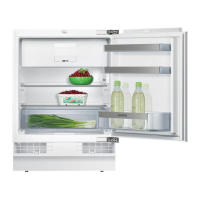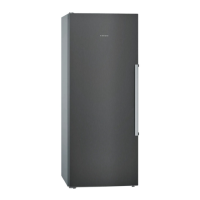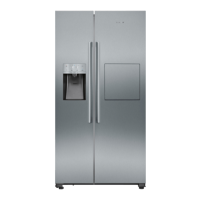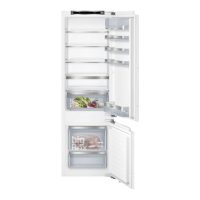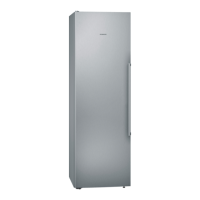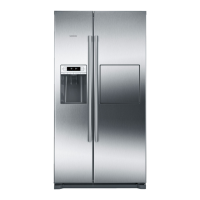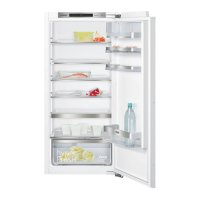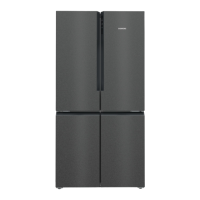Do you have a question about the Siemens iQ500 KG86N Series and is the answer not in the manual?
| Energy Efficiency Class | E |
|---|---|
| NoFrost | Yes |
| VitaFresh | Yes |
| Noise Level | 39 dB |
| Climate Class | SN-T |
| Number of Doors | 2 |
| Control Type | Electronic |
| Color | Stainless Steel |
| Type | Fridge freezer |
| Fridge Capacity | 279 l |
Read this instruction manual carefully. Keep the instruction manual and product information safe for future reference.
Only use this appliance for chilling and freezing food and for making ice cubes in private households.
Appliance may be used by children aged 8+ and people with reduced abilities if supervised or instructed.
WARNING – Risk of injury! The high weight of the appliance may result in injury when lifted. Do not lift the appliance on your own.
WARNING – Risk of electric shock! Incorrect installation is dangerous. Connect and operate only according to rating plate.
WARNING – Risk of electric shock! An ingress of moisture can cause an electric shock. Only use the appliance in enclosed spaces.
WARNING – Risk of electric shock! If the appliance or power cord is damaged, this is dangerous. Never operate a damaged appliance.
The packaging materials are environmentally compatible and can be recycled. Sort and dispose of them separately.
If you follow these instructions, your appliance will use less power. Select installation location carefully and save energy during use.
After unpacking all parts, check for any transport damage and for completeness of delivery. Contact dealer if complaints.
WARNING Risk of explosion! Ensure adequate space and ventilation for the appliance. Check permitted room temperature.
Install the appliance in accordance with the enclosed installation instructions. Ensure the subfloor is stable.
Remove informative material, protective foil, transit bolts. Clean the appliance for the first time.
Insert the mains plug into a socket. Check the mains plug is inserted properly. Appliance is now ready for use.
Overview of the parts of your appliance. Refer to Fig. 1 for details.
Use the control panel to configure functions and obtain information about the operating status. Refer to Fig. 2.
To vary the shelf as required, you can remove the shelf and re-insert it elsewhere.
Use the variable shelf to store tall items, e.g. cans or bottles, on the shelf below.
Store packaged food or small snacks in the snack container. You can remove the snack container.
Temperatures in the storage container are lower than in the refrigerator compartment. Store highly perishable food here.
Store fresh fruit and vegetables loose. Adjust humidity using the controller. Allows longer storage.
WARNING Risk of suffocation! Never remove the container divider from the frozen food container. It splits the container for better organisation.
Store butter and hard cheese in the butter and cheese compartment.
To adjust the door rack as required, you can remove the door rack and re-insert elsewhere.
Use the ice cube maker to make ice cubes out of drinking water.
Use original accessories. These have been made especially for your appliance. Accessories depend on the model.
Electrically connect the appliance. A warning signal sounds and display flashes if freezer is too warm.
Wait for set temperature before adding food. Front panels heat slightly to prevent condensation. Door may create vacuum.
Press and hold + for ten seconds to switch off the appliance.
Select compartment using °C, then press +/- to set temperature. Recommended fridge: 4°C, freezer: -18°C.
Prevents accidental operation. Press and hold 35 for three seconds to switch on/off. 35 lights up when active.
Cools the refrigerator compartment as cold as possible. Switch on before placing large quantities of food.
Cools the freezer compartment as cold as possible. Switch on 4-6 hours before freezing large quantities of food.
Energy-saving mode for when away. Refrigerator compartment heats up; do not store food there.
Sets appliance to save energy. Automatically sets temperatures for efficient operation.
Keeps food fresh for longer. Automatically sets temperatures. Refrigerator: 2°C, Freezer: unchanged.
Switches on if the appliance door is open for a while. A warning tone sounds and alarm appears.
Switches on if the freezer compartment becomes too warm. A warning tone sounds and display flashes.
Store food fresh and undamaged, covered or in airtight packaging. Avoid blocking ventilation openings.
Air circulation creates different chill zones. Coldest zone in storage container, warmest zone at the top of the door.
Indicates the quantity of food that can be frozen right through to the centre within a specific period of time.
Learn how to store the maximum amount of frozen food. Remove fittings, store food directly on shelves and floor.
Store food in airtight packaging. Do not bring unfrozen food into contact with frozen food. Place food evenly.
Freeze fresh and undamaged food in portions. Prepare vegetables and fruit properly. Includes lists of suitable and unsuitable foods.
Provides storage times for various foods like fish, poultry, and vegetables at -18 °C.
CAUTION Risk of harm to health! Defrost animal-based food in the refrigerator, bread at room temperature.
The refrigerator compartment in your appliance defrosts automatically.
The fully automatic NoFrost system ensures the freezer compartment remains frost-free. Defrosting is not required.
Switch off, disconnect from power, remove food and fittings. Take out all food and store it in a cool place.
WARNING Risk of electric shock! Do not use steam or high-pressure cleaners. Use a dish cloth, lukewarm water and pH-neutral liquid.
Remove shelves, snack containers, door racks, storage containers, and fruit/vegetable containers for thorough cleaning.
Remove the shelf above the fruit and vegetable container, front of container, and ice cube maker for cleaning.
During a power failure, temperature rises, reducing storage time. Check food quality immediately after power returns.
Perform a self-test to identify faults. Switch off, disconnect, reconnect, switch on, then press °C for 3 seconds.
Switch off, disconnect from power, remove food, clean the appliance, and leave it open to guarantee ventilation.
Valuable raw materials can be reused by recycling. WARNING Risk of harm to health! Leave shelves inside to prevent children climbing in.
Find product and production numbers on the rating plate. Make a note of them for Customer Service.



